Okay. I realize that today may not be a great day for posting another recipe. But I couldn't help myself.
I've been stocking up on some baked goodies the last few days, since Stu's brother Jeremy will be coming to stay with us in a few days for the holidays. I wanted to have a few things prepared to make for easy breakfasts and lunches – thus decreasing the amount of time I will be spending in the kitchen! Not that I don't enjoy my time in the kitchen…but never-the-less, I like to be prepared. So here we are.
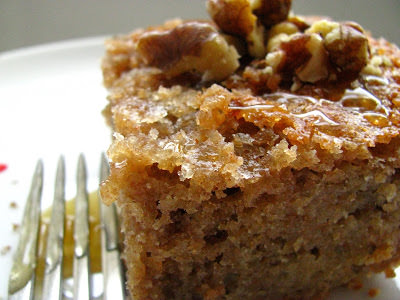
A few weeks ago, I began to ‘grow' my new sourdough starter. Last year, I began one from a starter packet…and everything I baked with it tasted like rocks. Except for these crackers and this cake, that is.
So after winter was over, I dumped the ‘ol starter and told myself I'd start another one next year….which is now this year…hence the reason I'm writing this.
Taking some tips from my Nourishing Traditions cookbook, this time I began my starter without buying any starter packets. I simply mixed organic rye flour with warm water, covered it with cheesecloth, fed it a little bit of rye flour and water each day for a week…and a sourdough starter was born!
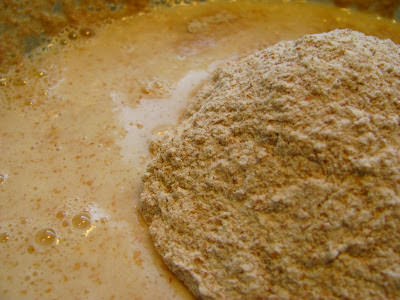
Here's my actual directions for a Homemade Sourdough Starter:
– Mix two cups of rye flour with two cups of warm water in a mixing bowl
– Cover with cheesecloth
– Each day for a week, transfer the starter to a new bowl and feed the starter 1/2 cup of rye flour and 1/2 cup of warm water
– Tip: If you aren't going to use the starter and want to slow it down so you don't have to feed it every day, simply cover it up and stick it in the fridge. Take it out a day before you want to use it and feed it accordingly.
Okay.
Now that we're growing our starter…I must say, this starter is so much better than my last one. I've made a few things already and am very pleased to announce that it works wonders! After allowing the dough to sour for a day or so, the dough actually looks like it's been yeasted – all bubbly and soft. It's a Christmas miracle!
The resulting baked goods were light, soft, and wonderful. No rocks of dough here!
I am giving you this homemade starter recipe so that you can begin this beautiful sourdough journey with me. I'm going to be posted a few sourdough recipes these next few weeks, and if you begin growing your starter now, you can hop right on this feremented bread train!
I know. Like you don't have anything else to do, right? No presents to wrap. No meals to cook. No laundry to do. No houses to clean. The only thing you have to worry about it growing your sourdough. Lucky you.
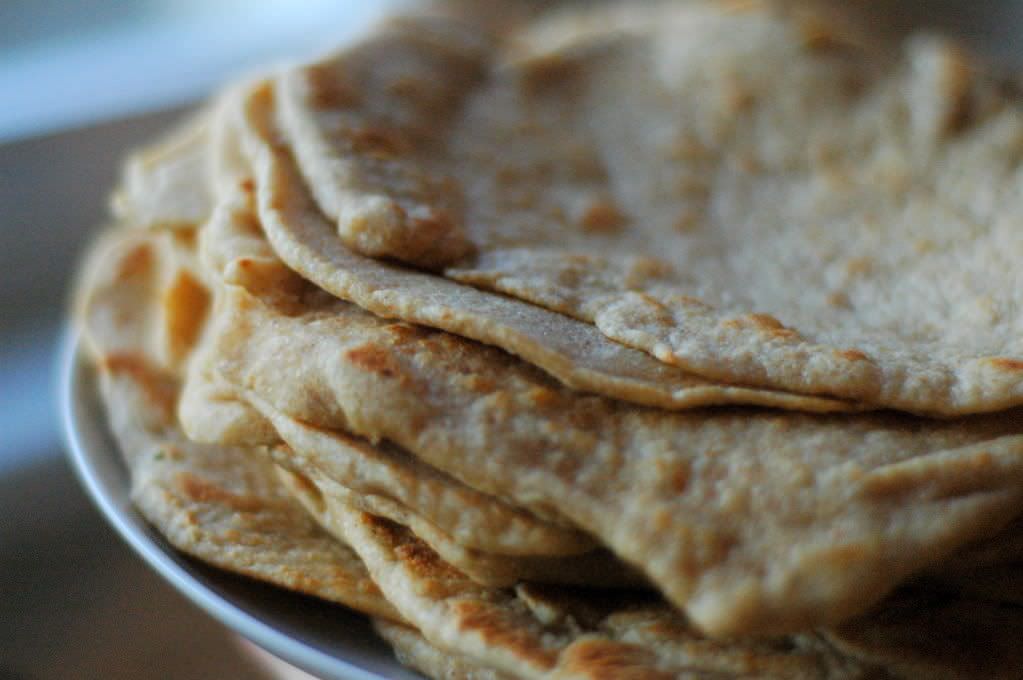
Here's the first of a few recipes that I am eager to share – homemade sourdough tortillas. These tortillas are very, very easy. I promise.
You will need:
Original recipe from Gnowfglins
– 3 cups of organic whole wheat flour (I used soft white wheat – aka – pastry flour), freshly ground is best!
– 3/4 cup water
– 3/4 cup sourdough starter
– 1/4 cup olive oil
– Pinch salt
Step One: Combine the water, flour, salt, and sourdough starter in your mixer or food processor. Keep adding flour, slowly, until the dough forms a nice ball without sticking too much to the sides of the mixer. Once you get the dough to a soft ball form, allow the mixer to knead the dough for 2-3 minutes (if you don't have a mixer, just do this by hand!) Transfer the dough to a well-oiled bowl, cover, and let this hang out on your counter for 12-24 hours.
Step Two: When you're ready to cook up your tortillas, heat up a griddle, cast iron skillet, or cooking pan of choice to medium-high heat. I don't bother with greasing or spraying my griddle. I like to use my large griddle so that I can have multiple tortillas going at the same time – it helps to speed up the process.
Step Three: Remove the dough from the bowl and transfer onto a greased surface. Gently divide the dough into walnut sized balls (this recipe will yield a dozen or so, depending on size).
Step Four: Grease your hands with a little olive oil and working with one ball of dough at a time, use your fingers to smoosh the dough out into a tortilla. I suppose you could use a greased rolling pin, but I find that using my fingers alone works fine. Sure, the shape isn't a perfect circle – but that's okay! It's homemade, remember?
Step Five: After rolling out the tortilla, gently and carefully move it to the hot skillet. Cook it for about 30 seconds per side, until a little golden and bubbly.

Step Six: You can either eat these immediately, or cool them off and store them in the fridge or freezer for later use. I have found that they reheat very easily and even stay soft. Yay!
The first meal we ate these with was fish tacos and they worked perfectly. I can't wait to cook up some gyros and curried chicken salad in them, too – they will work perfectly! We're also big breakfast burrito people, so I am excited to whip up a potato, bacon, and egg scramble to stuff inside – I know Stu and Jeremy will love that. They be lovin' them some burritos.
So, I realize that a few days before Christmas may not be the ideal time to take up cooking with sourdough. But heck, after Christmas, we are faced with three long months of winter before gardening begins. There couldn't be a better time to get all up in this sourdough's business.
Or you could always just come and steal some out of my fridge.
Either way.
For other great meal ideas, no matter what your dietary restrictions, check out the meal planning service I use: Real Plans.
Homemade Sourdough Starter
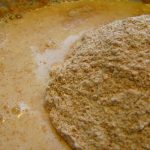
- 2 ½ cups rye flour
- 2 ½ cup warm water
Mix two cups of rye flour with two cups of warm water in a mixing bowl
Cover with cheesecloth
Each day for a week, transfer the starter to a new bowl and feed the starter 1/2 cup of rye flour and 1/2 cup of warm water
Tip: If you aren't going to use the starter and want to slow it down so you don't have to feed it every day, simply cover it up and stick it in the fridge. Take it out a day before you want to use it and feed it accordingly.
Homemade Sourdough Tortillas

Original recipe from Gnowfglins
Combine the water, flour, salt, and sourdough starter in your mixer or food processor. Keep adding flour, slowly, until the dough forms a nice ball without sticking too much to the sides of the mixer. Once you get the dough to a soft ball form, allow the mixer to knead the dough for 2-3 minutes (if you don't have a mixer, just do this by hand!) Transfer the dough to a well-oiled bowl, cover, and let this hang out on your counter for 12-24 hours.
When you're ready to cook up your tortillas, heat up a griddle, cast iron skillet, or cooking pan of choice to medium-high heat. I don't bother with greasing or spraying my griddle. I like to use my large griddle so that I can have multiple tortillas going at the same time – it helps to speed up the process.
Remove the dough from the bowl and transfer onto a greased surface. Gently divide the dough into walnut sized balls (this recipe will yield a dozen or so, depending on size).
Grease your hands with a little olive oil and working with one ball of dough at a time, use your fingers to smoosh the dough out into a tortilla. I suppose you could use a greased rolling pin, but I find that using my fingers alone works fine. Sure, the shape isn't a perfect circle – but that's okay! It's homemade, remember?
After rolling out the tortilla, gently and carefully move it to the hot skillet. Cook it for about 30 seconds per side, until a little golden and bubbly.
You can either eat these immediately, or cool them off and store them in the fridge or freezer for later use. I have found that they reheat very easily and even stay soft. Yay!

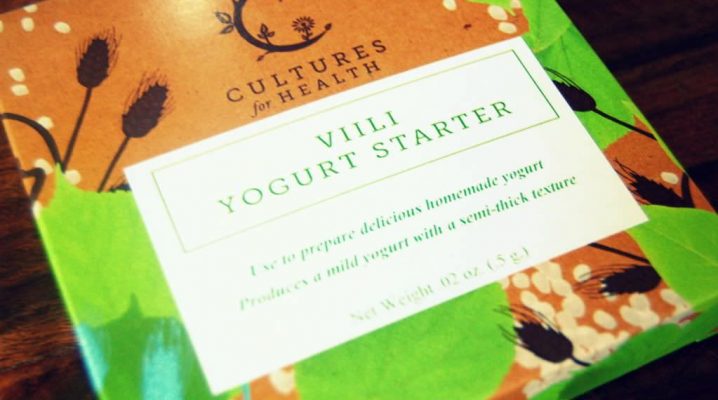
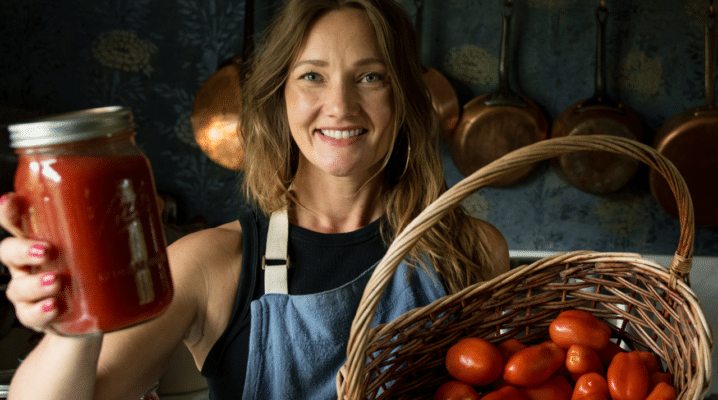
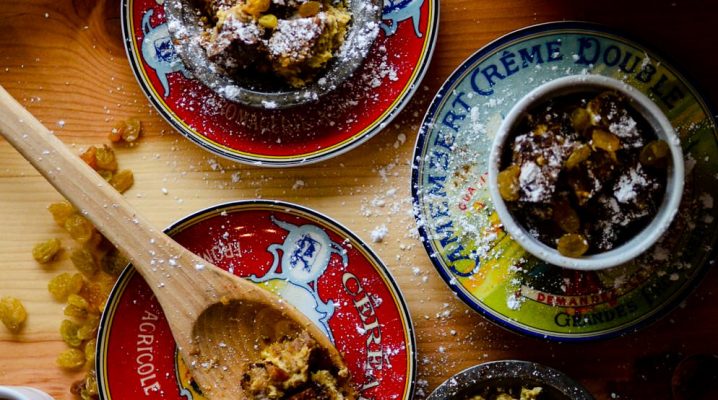
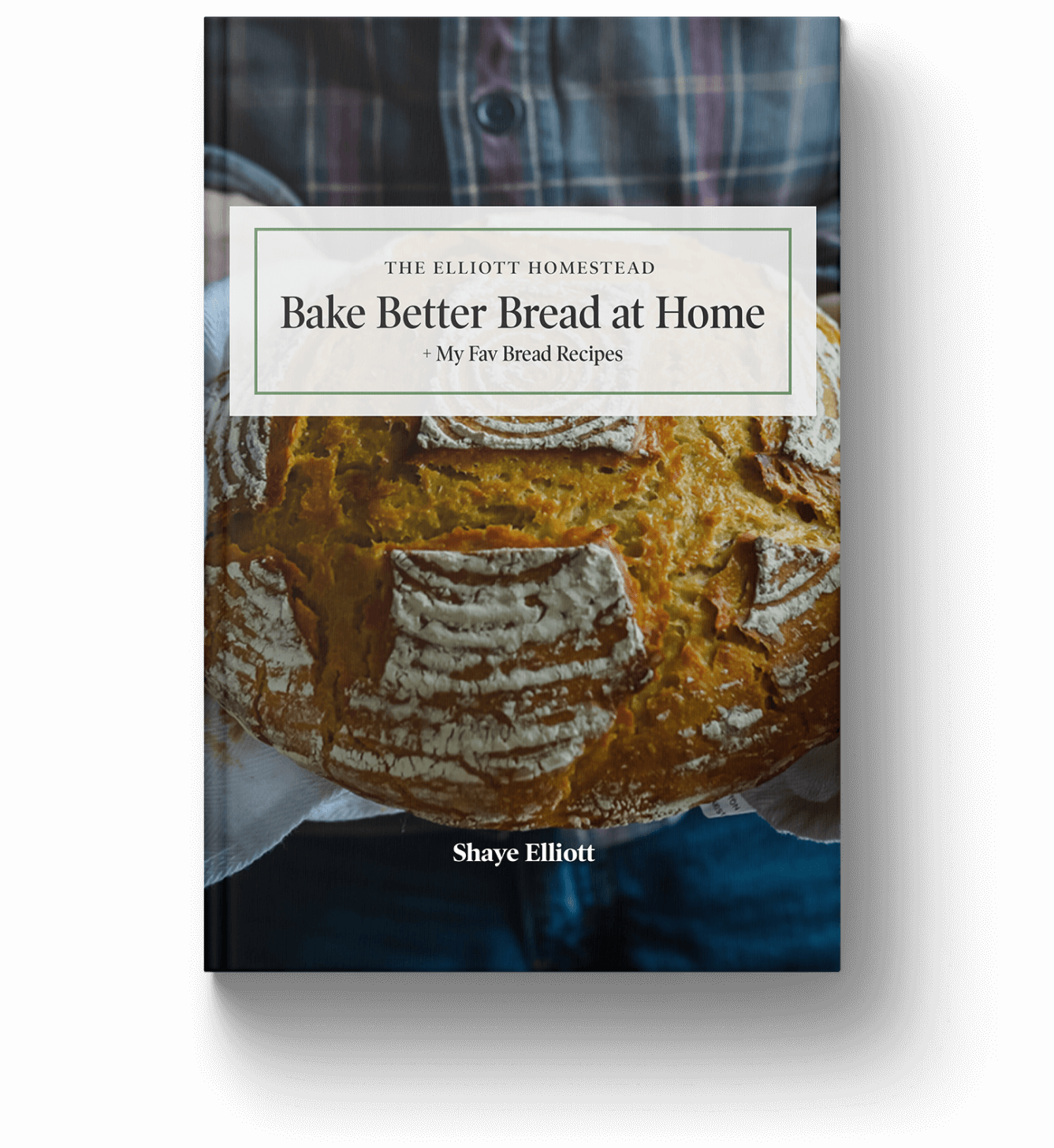
Where do you store the starter while it’s working it’s magic?
Great timing. I live way up in Canada and getting good tortillas is impossible. That’s not an exaggeration either. I’ve been wanting to make some and someone real nice bought me a tortilla press (it’s under the Christmas tree!). When we get back from holidays I will start this process. Question for you, if the starter is in the fridge, how long does it last in the fridge without “feeding it”? Do I need to take it out of the fridge once a month to keep it “going”?
I recently started following your blog and I must say it has been a delight. Thanks for the recipes – appreciate a good one anytime I can get it. 🙂
Thanks for this. You have no idea how long I have been pondering on how to make my own sour dough. This recipe seems so easy and approachable. I look forward to the recipes you come up with this winter. Thanks for sharing. Bless You!
Lyda – I store my starter on the kitchen counter, where it’s warm, but not hot. Anywhere room temperature should work. Are you going to try this? I wonder if fermenting the flour will help you be able to process it better without it affecting you as much?
France@beyondthepeel – If you keep your starter in the fridge, I would feed it once a week or so. I’m sure you could go longer, but to play it safe, I’d at least give it something every week.
Laura – thank you!
Erin J – Oh please, go get started on your own sourdough! Then we can experiment together! 🙂 It’s for sure a different approach to baking, but it’s so rewarding and fun to see how this all used to work before commercial yeast was available. Good luck!
Thanks for linking your great post to FAT TUESDAY. This was very interesting! Hope to see you next week!
Be sure to visit RealFoodForager.com on Sunday for Sunday Snippets – your post from Fat Tuesday may be featured there!
http://realfoodforager.com/2011/12/fat-tuesday-december-27-2011/
Thanks for posting this! I’ve been wanting to make soaked or sourdough tortillas for a while now, but hadn’t seen a good recipe until now. I’m excited to try this!
Sounds great – can’t wait to try this recipe.
When is the starter good to start using? Do I need to wait until the end of the first week? I’m going to start it today 🙂
Jenni
Jenni, you probably need to wait until the end of the first week. Did you? 🙂 How did they turn out?! It’s about time for me to get my starter going again…since it’s almost fall and all!
Just found your blog and im loving the recipes! Learning about soaking grains is totally new to me so I’m soaking, hahaha (pun intended) in the info!!
So my question is: If I refrigerate my starter it how much do I feed it weekly to keep it healthy?
Also with the traditional soaked whole wheat bread can I use some 6 grain flour in that recipe, and how much?
Thanks!
Ruth
Ruth, I feed my starter a cup of fresh rye flour each week while storing it in the fridge. As far as the soaked bread goes, I see no problem with supplementing in some of the 6-grain flour for the whole wheat, though I have no idea how much would still yield the same wonderful result. I’d start with maybe supplementing in 30% and if that yields a good result, maybe you could bump it up to 50% of whole wheat and 50% of the 6 grain.
Hope this helps!
Shaye
My starter is one week old and I’m trying to figure out if it’s alive! The first 2 days it expanded and bubbled really well etc. but now it bubbles less. I’ve read others who say it needs to be refreshed and you have to dump some of the started and oh my sooo complicated! Am I doing something wrong? The first two days it had a strong smell but now it doesn’t. Is my house too cool? Would that make it sluggish?
Thank you for all your help in advance!
Ruth
If you keep the starter out on your counter, you’ll want to “feed it” a half-flour, half-water ratio (ie: 1/2 cup water, 1/2 cup flour) each day. If you don’t need to use it and just want to keep it dormate, just put it in the fridge and feed it once per week or so. I’m sure your starter is still alive, just feed it some more flour and water each day and it should keep bubbling for you!
I am in the process of growing a starter, and today is day 7. It isnt bubbly and yeasted looking, however, and a couple days ago when I fed it and switched bowls, it had like a dark pool of water on the top of it. It wasnt like that today, and I have continued to feed it and am stumped if this is normal. It is really runny, and has a couple dimples on the top, where it might have started to foam, but barely. I was hoping to make your sourdough loaf today, but am concerned that my starter isnt alive. What would you do? Any suggestions?
The dark pool of water on top is totally normal. They call it ‘hooch’…which is sort of funny 🙂 It does sound like your starter is alive, just keep feeding it!
So once you’ve feed your starter for a week you can use it? Then do you store it in the fridge and use ir as often as needed? I’m confused.
Question: how soon can you use the starter? Do you need to wait the whole week? I ask because mine isn’t bubbly yet but it definitely smells sour.
Definitely wrote that before I read other comments. 🙂 Question answered!
Can you use sprouted wheat flour for the starter?
Er.. I meant rye, not wheat.
I don’t see why not!
Can I switch this to whole wheat flour after the initial birth of the starter? Rye is a bit more pricey around here.
You sure can. Sometimes, I also use organic, unbleached all-purpose flour. I’ve noticed that whole grains can get a little stinky smelling after awhile…
Just started another batch of starter a couple of weeks ago. I was impatient and used a sprinkle of yeast (1/4 packet, not quick rise) but with the whole wheat and butter milk I didn’t want to leave it on the counter. It takes a little longer to get a good flavor going but I use it more often now that I found this recipe, thank you. I made great Tortillas the first night but after letting the dough rise for the recommended 12 hours min. The Tortillas rolled much better on a well floured board, the texture was so much better, and the flavor oh my the flavor. Brings back memories of standing on a chair watching Grandma make Tortillas and me ready with the butter.
Thanks again and happy baking.
I have been feeding a spelt starter for almost a week (the kind you buy a little package of to start) and it’s looking ready to start using. I think you can answer this question for me. If I’m going to keep my starter on my counter and feed it every day does it matter who much starter is in my container or do I always just us a equal parts ratio of water and flour to feed it? So far while it’s been growing I’ve been using equal parts (by weight) for starter, water, and flour. I was wondering if I had to keep doing that forever because it would seem my only option is to throw away lots of starter every time (or of course find time to use it in a recipe).
Looking forward to enjoying healthy bread. Hopefully the learning curve will be short for baking. (I’ve already been grinding and soaking my own grains for over a year.)
Thanks for sharing your time!
This is awesome, thanks! 🙂
Hi~
Is the 1/4 cup olive oil just to grease your hands with? I didn’t see a mention to put it in the tortilla dough.
Thanks 🙂
I noticed the same thing. I wondered if Shay meant to say in Step one, “keep adding the OIL slowly” instead of “keep adding the flour slowly”
For the sourdough starter how to, do you have to transfer to a new bowl every time you feed the starter? Or can you just feed it and keep it in the same bowl/jar you are storing it in?
For the first week, I transfer it. After that, I change it to a new container each week and wash the old one – just to keep things clean.
When I replenish my sourdough starter I pour off all but 1T of starter and just add 3/4 cup each of water and flour(s). (I like to blend w/w and unbl. org. flours.) Leave it on the countertop at room temp. 8 hrs. or overnight. It should get light and bubbly. At that point mix into your bread recipe and reserve 1 T of starter to repeat. (You don’t even have to wash the starter container.)
If you are not ready to bake, refrigerate it. The sooner you use it, the more lively it will be. If you must store it for a length of time, I usually add the languishing starter to a batch of pancakes (rather than to throw it out) and replenish the starter again (1T reserved starter plus 3/4 c. each of flour and water).
I prefer using distilled water to avoid the contaminants.) PS. Never add anything to your starter except water and flour! It will keep for ages. To keep it while you move or for long periods, spread a spoonful or two onto wax paper and let it dry. Crumble into a ziploc baggie and seal. Bring it out when you are ready to resume baking. It may take a few refreshing cycles to activate it, but it will revive! I’ve had mine for decades! The secret to activating it is to use only 1Tb. starter. It loves to feed on the sugars in the flour. Too much starter and it won’t activate as quickly.
I am on day 3 of this sourdough starter recipe and am questioning if I am doing it correctly… So I am adding the 1/2 cup four and 1/2 cup water twice per day per the recipes instructions but should I be removing any starter when I add some? I looked at some other recipes and they are removing a lot every time they feed it. I assume you don’t since it is not in your instructions? So far I don’t see much if any bubble action and about an inch or so of water separates to the top as it sits. Help please! ; )
I have the same question as Jessica. Do i remove any starter when I feed during the first week?
Nope.
I’ve made my own sourdough starter in the past and felt like I was “wasting” a lot of flour by feeding it and then discarding, repeat, repeat, etc. etc. Is there a trick to being more frugal in the process or is it just the way the cookie crumbles?
You probably have found your answer by now, but the only reason to dump the starter is because if you don’t, you will end up with so much starter that you won’t know what to do with it. A good idea I’ve used is to use the “dumped” starter in pancakes or even in another bread recipe. Just adjust the recipe accordingly. Adds flavor, even if it’s not exactly where it should be at for a rise, it works well in other recipes just for the flavor. 🙂
I cannot find the sourdough starter recipe.
I am making the rye sourdough starter for the tortillas and hoping for a recipe using the starter for bread.